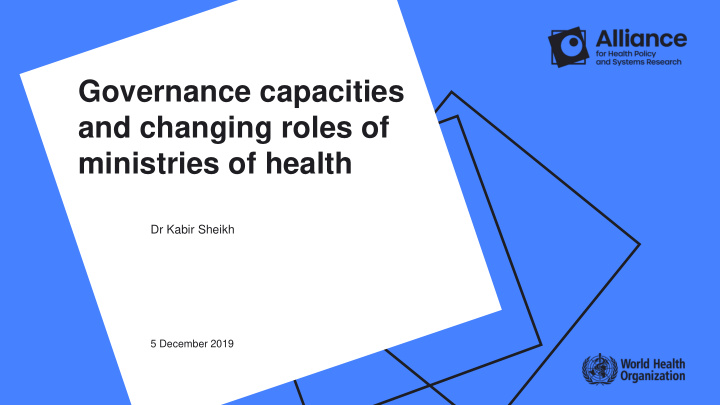



Governance capacities and changing roles of ministries of health Dr Kabir Sheikh 5 December 2019
Overview • Introduction and objectives • Framework • Literature review • Next steps
Introduction and objectives
The role of ministries of health in governance is evolving Centralized, hierarchal National Health Authorities Regulatory Provincial/Local Agencies Health Authorities Inclusive, collaborative Other Government Professional Authorities Councils
Changing contexts
Framing the governance role of ministries of health: what do we know? • Frameworks on health sector governance are multidisciplinary and multidimensional (Pyone et al. 2017, Barbazza et Tello 2014) – Responsibilities and tasks (examples: planning, policy development, regulation) – Extant challenges and issues (examples: corruption, political stability) – Principles and values (examples : transparency, participation, fairness) • Stewardship role of Ministries of Health (Veillard et al 2011, PAHO 2007) Two key lacunae: • The need for a unified framework that brings these dimensions and sub-dimensions together from the perspective of – Ministries of Health – The need for an actionable framework that addressed the issue of capacity and could be used for strategy development, benchmarking and/or research
Project goals • Objectives – Development of framework – Literature review • Outputs – Working paper to be published on the Collaborative webplatform – Articles for publication in peer-reviewed journals
Framework
Definitions Ca Capacity ty: Gov overn rnan ance : • «The ability to carry out stated • « Leadership and governance involves objectives » (Goodman et al. 1998) ensuring strategic policy frameworks exist and are combined with effective • « Capacity is the ability of an organization oversight, coalition building, the provision to function as a resilient, strategic and of appropriate regulations and incentives, autonomous entity » (Kaplan, 2007) attention to system-design and accountability» (WHO, 2007)
Framework Governance roles Performance area 1. De jure governance processes Implementation • • Policy development Contracting and compliance of de jure • • Strategic planning and prioritization Promotion of innovation responsibilities • • Regulation and standards Citizen empowerment 2. Preparation for and response to changes in context • • Governance of systems reform Response to macroeconomic and Resilience • Crisis management social change and relevance • • Response to political tranistions Response to global phenomena 3. Relaitonship management • • With political leadership With international organizations • • With civil society With funders and development Leadership and • With the labour force partners diplomacy • • With the private sector With parastatal and other health • With other ministries and sectors sector institutions 4. Values management Values • • Accountability and transparency Participatory processes • propagation and processes Efficiency processes goal alignment
Capacities Adapted from Potter and Brough, 2004
Expanded framework GOVERNANCE ROLES GOVERNANCE CAPACITIES PERFORMANCE AREA f Implementation of de jure De jure governance processes responsibilities f Performance Capacity Supervisory Capacity Structural Capacity Workload Capacity Personal Capacity Preparation for and response Resilience Role Capacity to changes in context and relevance f Leadership and diplomacy Relationship management f Values propagation and goal Values management alignment
Literature review
Current focus in the literature • More focus on capacities for mandated gove vernance ro roles – For example: evidence use/management and policy development • More literature on str structural cap apacity (ex: stablishing committees, units) and some on ro role cap apacity (ex: legislation) • Grey literature (and some peer-reviewed articles) describing capacity-building initiatives – lar largely donor-driven – More capacity building initiatives in the area of mandated governance roles • Description of some initiatives that engage re research or r le learning ap approaches – For example : Interactive Learning and Action combining research and managerial action
Gaps in the literature • Limited research and capacity building focus on « soft » dimensions of governance – Fewer articles and importantly interventions focused on relationships, uphold governance principles and navigate changing context – Some sub-dimensions of mandated roles, such as regulation and contracts, are underexplored • Less research on ‘human’ elements of pe pers rsona nal, wo work rkload or or supe superv rvisory ry ca capacity – and also how these types of capacity interact with role and structural capacity • Sus Susta tainability ty of capacity building programs Medium-to long-term assessments of capacity building programs – Performance capacity in the context of donor programs – – Fewer publications in peer-reviewed literature regarding capacity building, particularly country-driven efforts
Gaps in the literature, cont. • Fewer articles on other ‘underlying’ soft capacities – engaging politically, navigating complexity, building trust and learning reflexively (Woodhill 2011) – However, these concepts were not a core part of the search strategy • Fewer th theory-driven ap approaches to in-depth research on the topic – E.g., public administration or political science • Lack of precision on types of capacity – “ MoH lacks capacity to…”
Next steps
Potential uses for the framework Mapping and gap analysis for MOHs to chart their actual work against expected roles • and capacities for governance, and identify areas for capacity building Comparison and cross-learning to enable comparative analysis of governance roles • and capacities across different MOHs Benchmarking governance capacities where quantification and/or standardization is • helpful, e.g. per capita workload capacity • To enable in-depth analysis of MOHs governance capacities: e.g. synergies between different governance capacities, underlying reasons for capacity gaps, etc. • To enable plans to steer reforms of MOHs to facilitate the matching of governance roles with necessary capacity
Way forward • Refine framework with key stakeholder groups • Explore ways to test the framework at the country-level • Engage research communities in strengthening capacity alongside policymakers • Examine diverse cases of MoH governance capacities (for example, country-driven efforts, successful examples of sustainability, etc.)
Questions • How can we best use the framework to strengthen MoH governance capacities? • Ideas for collaboration between researchers and policymakers? • How do we incorporate a focus on ‘soft capacities’, such as reflexive learning and navigating complexity, in the framework?
Thank you! AllianceHPSR www.who.int/alliance-hpsr ksheikh@who.int
Recommend
More recommend